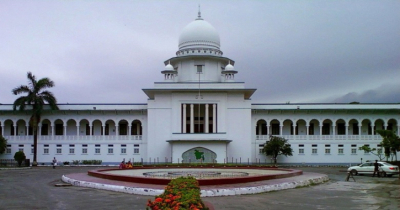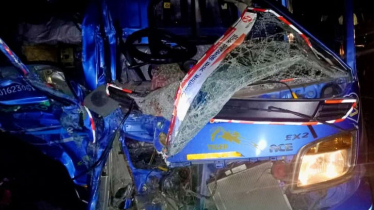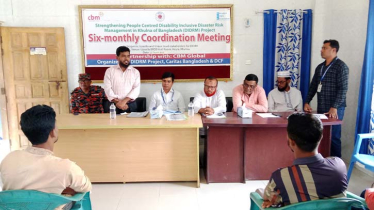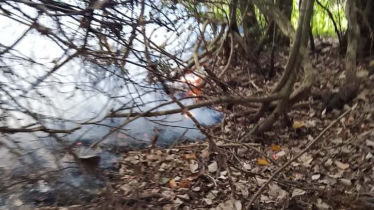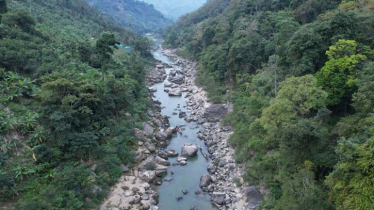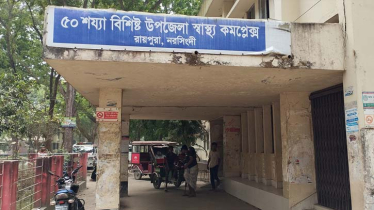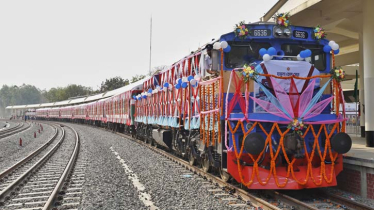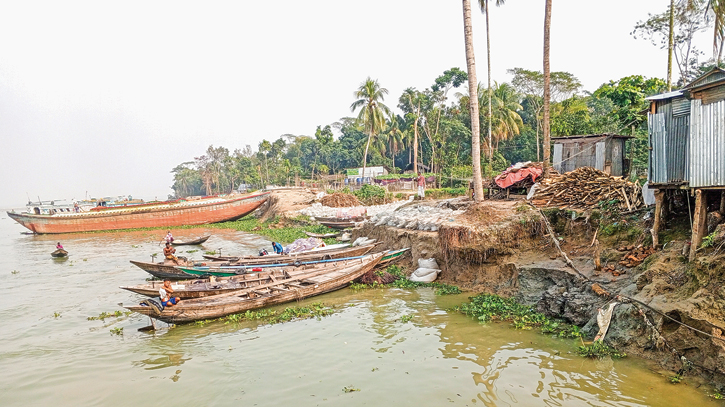
Caption: The past 15 years have witnessed the tragic displacement of approximately ten thousand residents along the Tetulia and Kalabodor rivers, leaving them homeless and bereft of their possessions due to the relentless erosion crisis. Photo: Messenger
The incessant and untimely erosion of the Tetulia and Kalabodor rivers has reached a critical juncture in the Shreepur union of Mehendigonj upazila. The past 15 years have witnessed the tragic displacement of approximately ten thousand residents, rendering them homeless and bereft of their possessions due to the relentless erosion crisis.
Elderly residents, Nurul Islam, 70, and Abu Taher, 50, have become vocal about their grievances, shedding light on the lack of effective initiatives to address erosion and protect the affected populace and their properties during this prolonged period of distress.
Despite local Member of Parliament Pankaj Debnath's attempt to mitigate the situation by placing sandbags along the erosion-affected riverbank in the Shreepur launch Terminal area two years ago, the majority were quickly washed away by the unyielding force of the rivers.
Khalid Bin Waled, the executive engineer of the Barishal office, has revealed ongoing efforts to conduct a comprehensive survey in the Sreepur area. Once the survey is complete, plans will be devised to deposit concrete blocks (C.C. blocks) along the riverbanks as a protective measure.
Conversely, the sub-assistant engineer of the Water Development Board Muladhi Office disclosed that the Barishal office has already initiated the deployment of 80 thousand sandbags to counter erosion in the Shreepur launch ghat area of the Kalabodor river.
The locals lament the loss of two bazaars, a high school, a Madrasha, a union parishad building, and three primary school buildings, along with approximately two thousand homesteads—all swallowed by the voracious rivers. The resulting displacement has forced numerous families to migrate to other parts of the country, which is particularly distressing in a union where most families are engaged in fishing and crop cultivation.
The devastation extends beyond human displacement, encompassing approximately two thousand acres of cultivated land eroded into the river. This has left numerous families unemployed and living in deplorable conditions within the union.
In a desperate plea for assistance, the affected locals are urging Prime Minister Sheikh Hasina to take immediate action by deploying concrete blocks along the erosion-affected riverbanks.
The plight of Shreepur union is emblematic of the larger issue of riverbank erosion in Bangladesh. Annually, the country grapples with millions affected by erosion, leading to the destruction of crops, farmland, and homesteads.
The socio-economic impact of riverbank erosion has disastrous socio-economic effects. The majority of the affected people perceive riverbank erosion as a natural phenomenon but in many cases, the people believe erosion to be the 'will of God'. However, these days, riverbank erosion is seen as one of the major causes for national poverty. The degree of economic loss and vulnerability of population due to bank erosion has dramatically increased in recent years. The impact of land loss involves primarily the loss of homestead land, housing structures, crops, cattle, trees and household utensils.
Studies estimate that around 5% of Bangladesh's total floodplain is directly impacted by erosion, affecting numerous upazilas. Urgent and comprehensive measures are imperative to address this endemic and recurrent natural hazard.
The relentless encroachment of riverbank erosion is not unique to Shreepur union but emblematic of a nationwide crisis in Bangladesh. The three mighty rivers—Ganges, Brahmaputra, and Meghna—reach their mature stages, resulting in sluggish and meandering patterns that cause widespread erosion. Addressing this crisis requires coordinated efforts and immediate action to prevent further loss and alleviate the suffering of those affected.
Messenger/Fardin

